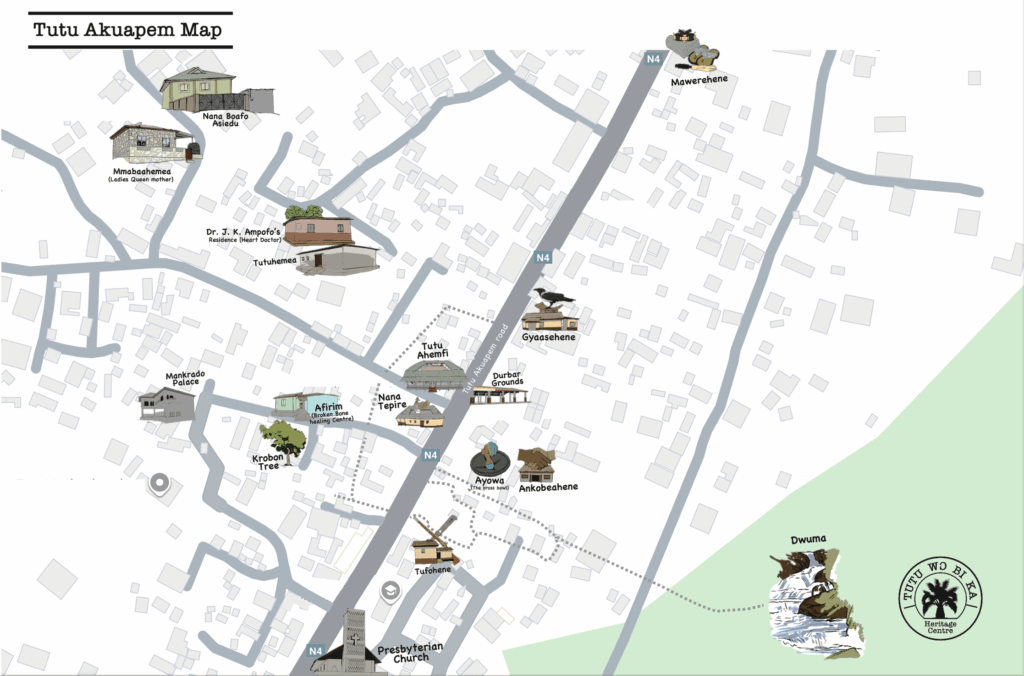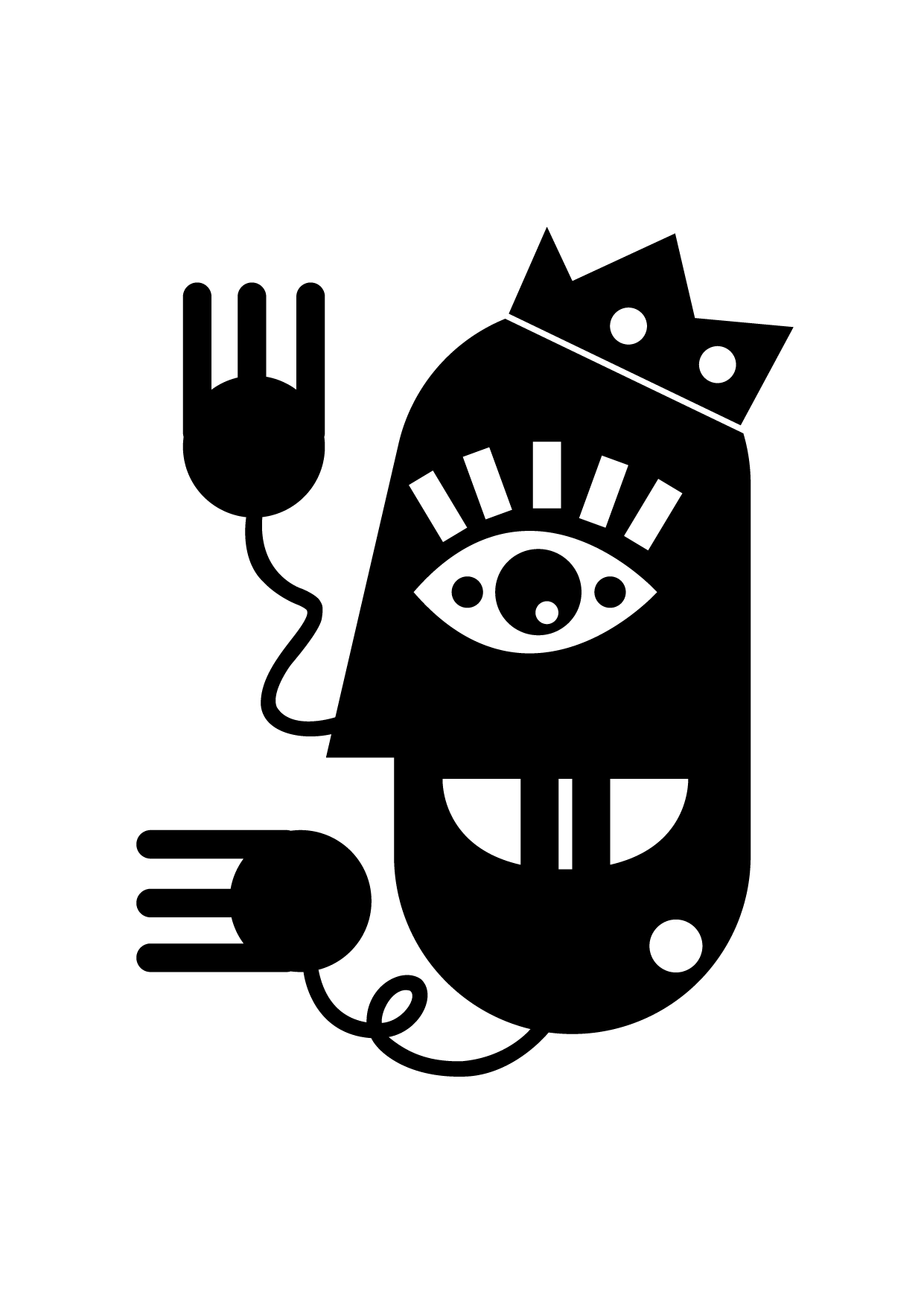
Welcome to Tutu Akuapem Historic Sites
Tutu is a small, beautiful town whose inhabitants are mainly subsistent farmers who grow plantain, cocoyam, cassava, among others. Nana Appiah Anti IV is the chief of Tutu, who also acts as the Atipimhene of the Akuapem Traditional Council. In terms of architecture, most of the houses are mud houses, which look slumy because of their belief in communal living.

This is situated in a house called Adoma, literally as Adom mma (children of grace), which was the Group that added to the first groups that started Tutu. The Adomas belongs to the Asona clan whose totem is a crow. In the history of Tutu, the Gyaasehene acts as the chief servant of the palace. Usually, the Adomas respond to the appellation, k)t)k), k) asia bra asia. Currently, the Gyaasehene of Tutu is Nana Asare Larbi who is the fourth in command in terms of the Tutu chieftaincy hierarchy.
The palace of the Tutuhemea is located at Funumaano, a suburb of Tutu Akuapem. Funumaano, which means the tip of the navel. The role of the Queen Mother in the town’s development has been very instrumental as her ideas and pieces of advice to the chiefs contribute to the growth of the town. Usually, the Queen Mother helps to lead the old women in the town. Presently, the sitting Queen Mother of the Tutu traditional council is Nana Owusua Ampiah.
Dr. Ampofo is a renowned herbal doctor who uses herbal medicines to heal various diseases and provide spiritual protection for people. He is also a native doctor who specialized in heart treatment. Today, he also operates as a commercial driver in Tutu. Ampofos herbal centre is also located at Furumaano in Tutu Akuapem.
Nana Akosua Brepo is currently the Mmabaahemea of Tutu Akuapem. She is located adjacent the house of Abusuapenin Kwasi Asiedu. In Tutu, the royal house for chief’s enstoolment is spearheaded by the family of Abusuapenin Kwasi Asiedu. History has it that, Abusuapenin Kwasi Asiedu was an illiterate but a renowned cocoa farmer with vast lands who even used his cocoa proceeds to build the family house for his people.
Is a very significant tree in the history of Tutu. It is situated close to the Aduana Abrade palace of Tutu and shares boundary with atifi Awurade, close to the Aduana Abrade palace. The krobon leaves were sweet scented leaves which were smeared on babies to smoothen their skins years ago. The krobon was also used to drive away evil spirits.
Tufohene is the chief in charge of guns and ammunitions of the town(Tutu) and Nana Boafo Asiedu was the Tutuhene of Tutu who passed on recently. According to history, Nana Boafo Asiedu has been the only longest serving chief on the Akuapem ridge who has ruled for sixty-nine (69)years. It is believed that he had a secret to longevity that was why he ruled for sixty-nine years. The palace of Nana Boafo is situated at Furumaane in Tutu Akuapem.
The Ankobeahene is the chief advisor to the Tutuhene. He is crucial in the day-to-day activities of the chief, as he also helps receive visitors before directing them through the linguistics on behalf of the chief. The Ankobeahene’s palace is also known as the Kobotutu ahemfi.
He is the chief in charge of the costumes and accessories of the chief of Tutu. Therefore, whenever there’s an occasion, he ensures that the chief is costumed correctly to suit the occasion. Nana Akuffo Kwapong is the Mawerehene of Tutu.
It is a sacred place in Tutu which had a deep well-like structure with fresh water springing from it. It was known that the water from Dwuma never dried and mostly meets with the Yaw Wontumi River at the royal lane. As a sacred place, rituals are performed annually in honour of Dwuma. During the performance of the rituals, animals are used as sacrifices, accompanied by incantations from the linguist of Anokobeahene. Unfortunately, the fresh water has now dried up, but the ritual is always enacted.
It is a traditional place of worship for everyone. Tepire is the god of Tutu who is worshipped by the Tepire priest known as Osofo Mante. It is place for divination and all spiritual consultation.
The Brass bowl in Tutu landed in an area called Kobotutu. According to history, that area was a thick forest with a lot of wildlife. A great hunter named Apɛkonam who is believed to have come from Krobon went for hunting in the forest and saw a brass bowl descending from the sky. Out of fear, he moved away but was lured by the beautiful woman (add male) in the brass bowl known as Yeye Amoakoa, from Kobotutu.
Apɛkonam drew closer and took Yeye Amoako to his residence. They lived together and gave birth to children who became inhabitants of Tutu Akuapem known as furumaano mma (children from the tip of the navel)
Afirim is a place located at Krobon, a suburb in Tutu. It is a broken bone healing center which is known for healing all kinds of bone complications. The center was a vibrant place that received referrals from renowned hospitals in the country. At Afirim, they use hot water and herbs with some spiritual direction to heal. Aside that there are some rituals that are performed with fowls and other items to provide healing for the injured person. Afirim also uses various herbs to provide spiritual protection and powers for people who visited. Today, the bone healing act has extinct because all those who took over are no more hence the death in its transmission.
ƆBƆMMƆFO ANKAMA AKOSƐM NE ABUKURUWA BI
Obomofo Ankama
Obomofo Ankama
Contributors: National Folklore Board, Art Haus, National Commission on Culture, Laquaye Glover-Tey – Structural Advisor, Okyeame Frederick Akuffo – Chief Linguist, Ankobea Ofori Akrofi – Tutu Secretary, Kofi Setordji – Senior Artist, Ada Facchini – Project Manager (Italy), Valerie Asiedua Akoto – Project Manager (Ghana), Eric Agyare, Project Director, Massimo Carozzi – Sound Artist, Kizito Amartey – Artist, Clare Asantewaa Afari – Writer, Gianle Lametá – Artist, Albert Nii Korley – Sound Artist, Bright Tetteh Ackwerh – Illustrator
Quick Link

P. O. Box CT 3683
Cantonments, Accra, Ghana
Email: we@artlifematters.org


